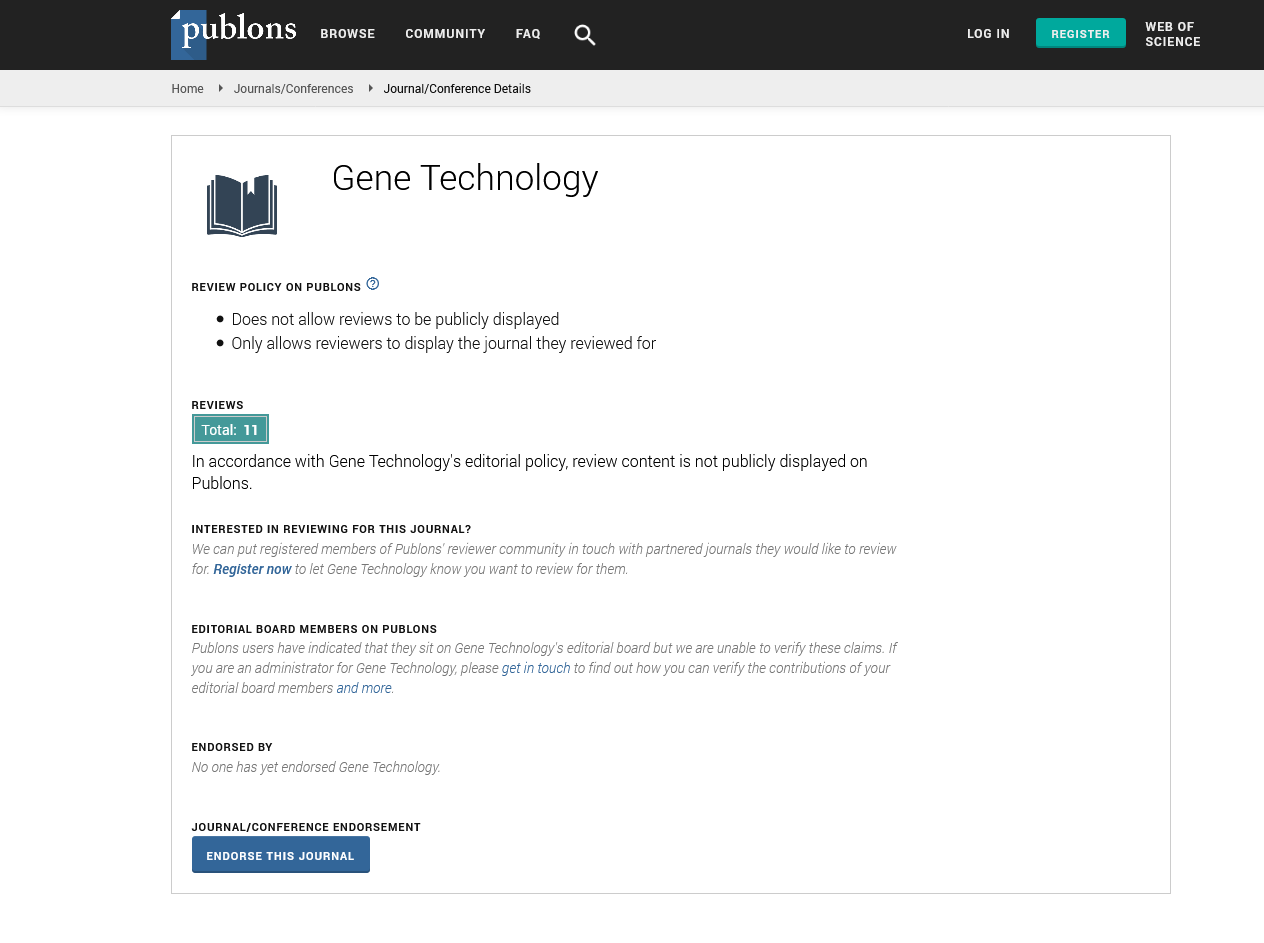Indexed In
- Academic Keys
- ResearchBible
- CiteFactor
- Access to Global Online Research in Agriculture (AGORA)
- RefSeek
- Hamdard University
- EBSCO A-Z
- OCLC- WorldCat
- Publons
- Euro Pub
- Google Scholar
Useful Links
Share This Page
Journal Flyer

Open Access Journals
- Agri and Aquaculture
- Biochemistry
- Bioinformatics & Systems Biology
- Business & Management
- Chemistry
- Clinical Sciences
- Engineering
- Food & Nutrition
- General Science
- Genetics & Molecular Biology
- Immunology & Microbiology
- Medical Sciences
- Neuroscience & Psychology
- Nursing & Health Care
- Pharmaceutical Sciences
Short Communication - (2024) Volume 13, Issue 3
Zinc-Finger Proteins and Hox Chromatin Boundaries: Implications for Gene Regulation
Mia Robinson*Received: 30-Aug-2024, Manuscript No. RDT-24-28170; Editor assigned: 02-Sep-2024, Pre QC No. RDT-24-28170 (PQ); Reviewed: 16-Sep-2024, QC No. RDT-24-28170; Revised: 23-Sep-2024, Manuscript No. RDT-24-28170 (R); Published: 30-Sep-2024, DOI: 10.35248/2329-6682.24.13.296
Description
The regulation of gene expression during development is a highly coordinated process that involves the precise control of chromatin structure and the activation or repression of specific genes at the right time and place. Recent advances in the study of Hox gene regulation have revealed that members of an array of zinc-finger proteins play an essential role in defining distinct chromatin boundaries for these genes [1]. The role of zinc-finger proteins in the specification of these boundaries represents a novel aspect of how the genome is organized during development, influencing the expression patterns of Hox genes that are critical for the proper development of various body structures [2].
Hox genes are a family of transcription factors that control the patterning of the body plan during embryonic development. They are organized into clusters on the chromosome and their expression is regulated in a spatially and temporally precise manner [3]. The correct regulation of Hox gene expression is essential for the proper formation of structures such as limbs, the spine and the brain. Disturbances in Hox gene regulation can lead to developmental disorders, making it essential to understand the mechanisms that control their expression. One of the key aspects of this regulation involves the establishment of chromatin boundaries, which serve as barriers to prevent inappropriate gene activation or repression within the Hox clusters [4-6].
Recent studies have shown that zinc-finger proteins are involved in specifying these chromatin boundaries. Zinc-finger proteins are a class of transcription factors that contain zinc ions coordinated by cysteine and histidine residues in a finger-like structure [7]. These proteins are known to bind specific DNA sequences and regulate gene expression by either activating or repressing transcription. In the context of Hox genes, zinc-finger proteins are implicated in the formation of chromatin domains that delineate the regions of the genome where Hox genes are active or inactive. By binding to specific regions within or around the Hox clusters, these proteins help to establish boundaries that prevent the spreading of active or repressive chromatin marks into adjacent genomic regions [8].
The discovery that zinc-finger proteins help define chromatin boundaries in the Hox clusters has significant implications for our understanding of gene regulation [9]. It highlights the importance of chromatin architecture in controlling gene expression and reveals the complex mechanisms that cells use to maintain the integrity of gene expression patterns during development. By establishing these chromatin boundaries, zincfinger proteins ensure that the appropriate Hox genes are expressed in the correct tissues and at the right time, preventing cross-talk between neighboring genes that could lead to developmental defects [10].
Furthermore, this research opens new methods for investigating how chromatin boundaries are established and maintained across the genome. It suggests that zinc-finger proteins might play a broader role in organizing chromatin in a way that is not limited to Hox genes, but could also apply to other gene clusters or regulatory regions. Understanding the principles behind chromatin boundary formation could provide insights into the regulation of other important genes involved in development and disease, including genes related to cancer and other genetic disorders.
Conclusion
In conclusion, the identification of zinc-finger proteins as key regulators of Hox chromatin boundaries enhances our understanding of how gene expression is tightly controlled during development. By specifying these boundaries, zinc-finger proteins help ensure the precise activation and repression of Hox genes, which is critical for normal body patterning. This discovery not only contributes to the broader field of developmental biology but also provides new perspectives on the regulation of chromatin structure and its implications for gene expression. Further research into the mechanisms behind chromatin boundary formation could lead to novel strategies for manipulating gene expression in therapeutic contexts, with potential applications in treating developmental disorders and other diseases.
References
- Ortabozkoyun H, Huang PY, Gonzalez-Buendia E, Cho H, Kim SY, Tsirigos A, et al. Members of an array of zinc-finger proteins specify distinct Hox chromatin boundaries. Mol cell. 2024;84(18):3406-22.
[Crossref] [Google Scholar] [PubMed]
- Gosztyla ML, Zhan L, Olson S, Wei X, Naritomi J, Nguyen G, et al. Integrated multi-omics analysis of zinc-finger proteins uncovers roles in RNA regulation. Mol cell. 2024;84(19):3826-42.
[Crossref] [Google Scholar] [PubMed]
- Kinreich S, Bialer-Tsypin A, Viner-Breuer R, Keshet G, Suhler R, Lim PS, et al. Genome-wide screening reveals essential roles for HOX genes and imprinted genes during caudal neurogenesis of human embryonic stem cells. Stem Cell Rep. 2024;19(11):1598-619.
[Crossref] [Google Scholar] [PubMed]
- Yadav C, Yadav R, Nanda S, Ranga S, Ahuja P, Tanwar M. Role of HOX genes in cancer progression and their therapeutical aspects. Gene. 2024;919:148501.
[Crossref] [Google Scholar] [PubMed]
- Hu X, Wang Y, Zhang X, Li C, Zhang X, Yang D, Liu Y, Li L. DNA methylation of HOX genes and its clinical implications in cancer. Exp Mol Pathol. 2023;134:104871.
[Crossref] [Google Scholar] [PubMed]
- Dhillon V, Aguilar J, Kim P, Padmanabhan D, Dhiman S, Dyson G, et al. Clinical Significance of HOX and Meis gene Expression Profiling in Acute Myeloid Leukemia. Blood. 2024;144(S1):6162.
[Google Scholar] [PubMed]
- Yu J, Fang M, Shi L, Zhu J, Fu C, Zhang Y, et al. High efficiency removal of antibiotic resistance gene with designer zinc-finger protein. Bioresour Technol. 2024;413:131462.
[Crossref] [Google Scholar] [PubMed]
- Gosztyla ML, Zhan L, Olson S, Wei X, Naritomi J, Nguyen G, et al. Integrated multi-omics analysis of zinc-finger proteins uncovers roles in RNA regulation. Mol cell. 2024;84(19):3826-42.
[Crossref] [Google Scholar] [PubMed]
- Zhang X, Azhar G, Zhong Y, Wei JY. Zipzap/p200 is a novel zinc finger protein contributing to cardiac gene regulation. Biochem Biophys Res Commun. 2006;346(3):794-801
[Crossref] [Google Scholar] [PubMed]
- Kherdjemil Y, Kmita M. Insights on the role of hox genes in the emergence of the pentadactyl ground state. Genesis. 2018;56(1):e23046.
[Crossref] [Google Scholar] [PubMed]
Citation: Robinson M (2024). Zinc-Finger Proteins and Hox Chromatin Boundaries: Implications for Gene Regulation. Gene Technol. 13:296.
Copyright: © 2024 Robinson M. This is an open-access article distributed under the terms of the Creative Commons Attribution License, which permits unrestricted use, distribution, and reproduction in any medium, provided the original author and source are credited.

